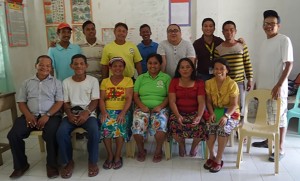Dionisio Escabusa, 72, tribal chieftain of Eskaya tribe in Barangay Lundag, Pilar, Bohol expressed that introducing Kalahi CIDSS program in 2006 to the community was easy because community-driven development (CDD) approach is in agreement with their practices.

“Every member of our community is involved and has a voice when it comes to decision making”, said Escabusa.
What the community had difficulty on the process was in complying with the different documents needed for the sub-project implementation. However difficult the process may seem, there is always a way the Eskayas can do about it.
They diligently attended the various training on procurement, finance and infrastructure initiated by DSWD for them to know how to manage the implementation of the sub-project.
The Kapit Bisig Laban sa Kahirapan – Comprehensive and Integrated Delivery of Social Services (Kalahi – CIDSS) is one of the three core social protection programs of the Department of Social Welfare and Development (DSWD). It uses the CDD strategy to empower ordinary citizens to actively and directly participate in local governance of identifying their own community needs, planning, implementing and monitoring projects together to address local poverty issues.
Before Kalahi – CIDSS came to barangay Lundag, the Eskaya tribe was said to have faced many challenges for their survival. The tribal members had to travel 15 kilometers for about three-hours by foot to reach the town proper, passing on the slippery, muddy road with huge rocks especially during rainy days, carrying their farm produce such as root crops.
This mode of traveling from the barangay to the town proper affected the quality of their root crops. When they sold it, the price would be lesser than what they wanted to get from the buyers.
“We are thankful to the government programs that have entered our municipality, it helped us a lot especially now that we already have concrete roads in our barangay” said Emiliano Amor, tribe elder in his dialect.
He added that the 100 meters improvement of Barangay Lundag farm-to-market road under Kalahi CIDSS Kapangyarihan at kaunlaran sa Barangay (KKB) and the additional 190 meters concreted farm-to-market road under Kalahi CIDSS Makamasang Tugon year 2012 has made their life easier because they were able to improve roads which are accident prone.
In 2014 Kalahi CIDSS – NCDDP started its implementation as a disaster response classified as Yolana hit areas. Pilar, Bohol was classified under 377 or poor and Yolanda affected and has three years of implementation.
“Majority of the tribal members decided to rehabilitate our barangay hall because its structure was weakened by the 7.2 magnitude earthquake that hit us in 2013. Also rust ate away the building’s steel bars keeping it unsafe for occupancy,” said Barangay Captain Edilio Balaba in his local dialect.
The DSWD through Kalahi – CIDSS granted Brgy. Lundag a total of Php 884,309.00. However, the actual sub-project cost reached a total of Php 1,187,000.00 because of the community’s local counterpart contribution and barangay’s counterpart contribution.
Barangay Lundag is the farthest upland barangay of the municipality situated at the municipal boundaries of the adjacent towns of Guindulman and Duero. It is bounded on the north by Barangay San Vicente, Pilar; on the east by Barangay Biabas of the Municipality of the Guindulman; on the south by Barangay Taytay Duero; and on the west by Barangay Bagacay, Pilar.
Now, with the road improvement projects in the village. Brgy. Lundag ‘s travel time from the town proper to the barangay proper is 45 minutes by a motorcycle –for-hire locally known as “habal-habal”.
With the success of CDD, decision making of the Eskaya tribe does not solely come from the tribal council, it is now transitioned to involving majority in their community. ###
(19) Views